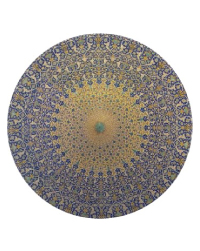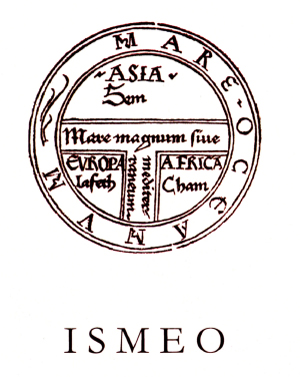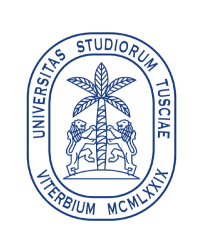



Tenth International Conference on Iranian Linguistics
(ICIL 10)
13-15 January 2025
University of Tuscia (Viterbo)
Conference Venue
The conference will take place at the Santa Maria in Gradi complex of the University of Tuscia in Viterbo (Italy), where the DISUCOM (Department of Human Sciences, Communication and Tourism) is located. The Santa Maria in Gradi complex is close to Porta Romana and within walking distance (about 15 minutes) from the historic city centre.
Address: Via Santa Maria in Gradi, 4, 01100 Viterbo (VT); driveway entrance from Via Sabotino.
The location of all University seats can be checked here.

The Conference will take place in the Radulet Room, located on the first floor of the main building (highlighted above).
A floor plan is available here: ❍
History of the Santa Maria in Gradi Complex:
The Santa Maria in Gradi Church was built in the 13th century. After the construction of the church, the city wall was extended to include the monastery and three watchtowers were built to protect it.

The monastery is characterized by the presence of two cloisters and a portico in front of the entrance to the church. The portico is a 15th century replacement of a previous structure. The first cloister features a well dating to 1557, while in the middle of the second (17th century) cloister there is a fountain bearing the coat of arms of the Chigi family.

The monastery complex was fully restored between 1737 and 1758 by Nicolò Salvi, the world-famous architect who designed the Trevi Fountain in Rome. After surviving World War II, the church was damaged while serving as a prison.
Discover more about Viterbo and the Tuscia Viterbese region:
Viterbo (Italian: [viˈtɛrbo]; Viterbese: Vetèrbe; Medieval Latin: Viterbium) is a comune (municipality) and province seat in the Lazio region of Italy. The city is currently home to ca. 67.000 inhabitants and is located about 80 km (50 miles) north of the Great Ring Juncture, the motorway that encircles Rome, on the ancient Via Cassia. Sightseeing map of the city:

The city of Viterbo lays in a region of northern Lazio known as Tuscia or Alto Lazio, surrounded by the Cimini and Volsini Mountains. The whole area is of Etruscan heritage. Although the settlement of Viterbo is older, its historical core began to develop in medieval times (around the year 1000) near the Castrum Viterbii on Colle del Duomo. This is why the city boasts one of the largest and better preserved medieval historic centres in Europe. The layout of the city is surrounded by high fortified walls with massive towers, built during the 11th and 12th centuries, and the entrance to the historic city centre is via a series of gates (porte), among which Porta Romana (in the picture below).

During the Late Middle Ages, Viterbo experienced considerable growth and started to compete with Rome, eventually becoming Papal Seat in 1257. For twenty-four years Popes were elected and hosted at the Papal Palace of the city: this is why Viterbo is also known as “the City of Popes”.

Viterbo preserves historical monuments ranging from the Middle Ages to the Renaissance and beyond: aristocratic palaces, churches, as well as beautiful fountains made of ‘peperino’ (the typical stone of Viterbo buildings). Viterbo is unique in Italy for its well-preserved ‘profferli’, the characteristic external staircases of medieval houses.

Viterbo is also known for the religious tradition of the ‘Macchina di Santa Rosa’, an illuminated tower (30 meters high, weighing 52 quintals) carried on the shoulders of a hundred men through the streets of the city in honour of Saint Rose, the city’s patron, every year on the evening of September 3rd. In 2013, this event was included in the UNESCO Representative List of the Intangible Cultural Heritage of Humanity.
Apart from cultural heritage, the main resources of Viterbo’s area are linked to agriculture and a thriving craftsmanship (pottery, marble, wood). Viterbo is also home to the Italian gold reserves, to the headquarters and training centre of the Italian Army aviation brigade, to an Academy of Fine Arts and, of course, to the University of Tuscia.
Viterbo Province is also famous for its natural environment, rich in protected reserves, wilderness areas, and thermal springs. Just outside the city, in the Soriano del Cimino municipality, you can visit the Ancient Beechwood of Mount Cimino (Faggeta Vetusta del Monte Cimino), declared UNESCO Heritage Site in 2017.

The landscape of the Tuscia Viterbese is diverse, including mountains and forest areas, major lakes (Vico and Bolsena), as well as beautiful coastal stretches. The region is crossed by the so-called ‘Via Francigena’ (literally, the road that comes from France), an ancient pilgrimage route leading to Rome, whose itinerary can still be walked by tourists and pilgrims today.
The Tuscia Viterbese boasts important archaeological sites, especially Etruscan necropolises and settlements (such as Tarquinia and Sutri). Further historical-artistic attractions in the vicinity of Viterbo are the Romanesque churches of Tuscania; the Renaissance Farnese Palace of Caprarola; the Villa Lante of Bagnaia with its “Italian gardens”; Civita di Bagnoregio, a small town accessible only on foot and known as “the dying city”; and the famous Parco dei Mostri (Monster Park), a labyrinth of gigantic statues and monster-like creatures created in 1552 by Pierfrancesco II Orsini duke of Bomarzo.
__________
02.07.2024
